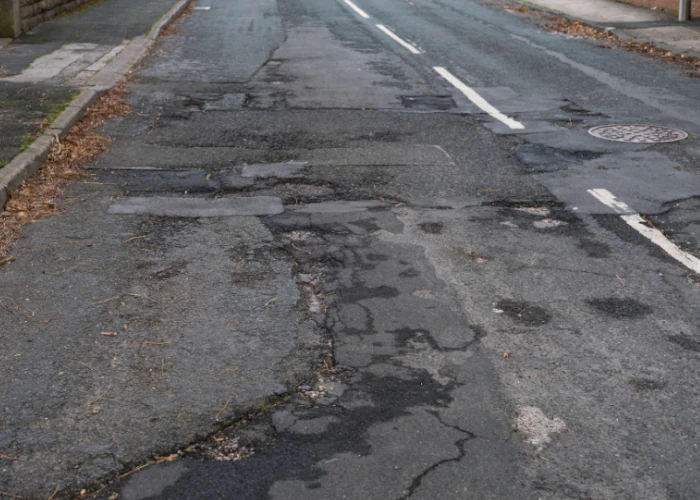
The condition of the UK’s road network leaves much to be desired. The ongoing "Pothole Crisis" presents real safety concerns for all road users, especially cyclists. It is now estimated that around 20% of cycling injuries can be attributed to poorly maintained road surfaces.
In this guide we set out the various things you can do that, in aggregate, can significantly reduce the likelihood of you being injured as a result of a road defect.
Choose the safest route
If you can, choose routes that are less likely to have rough road conditions. Digital maps and local cycling forums are a great place to find routes and paths offering smoother surfaces.
Pay attention to road conditions:
Stay alert to the road ahead, constantly scanning for obstacles, potholes, and rough patches. Make necessary course adjustments in advance, avoiding sudden swerves or sudden braking if you can.
Choose a suitable bike
If you are looking for a new bike, think about how you intend to use it before choosing. Consider using a bike with wider tires, which can provide better shock absorption and stability. Mountain bikes and hybrid bikes typically have suspension which can make a huge difference in rough road handling. You can always fit road tyres to a mountain bike to significantly reduce rolling resistance.
Fit larger tyres
Many cyclists are opting for larger tyres and modern road bike frames and forks often allow for larger tyres to be fitted. 28C, 32C, or even 35C tyres let you run lower tyre pressures and enjoy far better shock absorption, without adding much in the way of rolling resistance.
Maintain the right tyre pressure
The correct tyre pressure (according to the manufacturer's recommendations) is your first line of defence against road imperfections and potholes. Lower pressures can give you better grip and shock absorption, but if the pressure is too low you risk getting a ‘pinch flat’.
Choose tubeless tyres
If your wheels are compatible, tubeless tyres can be fitted and used with less pressure than standard clincher (inner tube) tyres as they don’t have an inner tube.
Larger wheel size
Bicycle wheels with a larger diameter have a better chance of gliding over a rough surface or pothole, instead of getting caught in it.
Larger wheels also offer reduced impact, better momentum preservation, improved stability, and enhanced shock absorption. Look for bikes with larger 700C (700mm diameter) wheels.
Maintain a steady pace
Maintain a consistent and steady pace when cycling over poor road surfaces. Avoid sudden jerks or quick manoeuvres (unless you have no option) that could unbalance you. A smooth and controlled riding style is recommended on uneven terrain more effectively.
Alert others
If you ride with other people, establishing a group habit of pointing out potholes as you ride is critical, especially if you ride in a close group formation where an approaching pothole might be absurd by the rider in front.
Use the correct riding position
If you can’t avoid a pothole or rut, you should adjust your riding position to absorb shocks efficiently. Slightly bend your elbows and knees, allowing your body to act as a natural suspension. Shifting your weight slightly to the rear helps you to keep better traction on the rear wheel and reduce the chance of your front wheel getting stuck.
Avoid tight grips
Maintain a relaxed grip on the handlebars. A tight grip can transmit more vibrations and shocks to your body, leading to discomfort and fatigue. Relaxing your grip will help absorb some of the impact of a rough road.
Learn how to bunny hop
Mastering the bunny hop technique can help you avoid even the worst potholes. By pulling on the pedals and handlebars simultaneously you can jump both wheels over the pothole. Practice bunny hopping on a quiet piece of road and you will soon master the technique.
If you do find yourself rapidly approaching a pothole and you have not mastered bunny hopping, you can also flick your bike around with a small but rapid swerve.
If you cannot avoid the pothole, don’t brake and try and cross it at a perpendicular angle.
Avoid puddles
There is no way to tell what an approaching puddle many be hiding. Assume there is a nasty pothole underneath the puddle and avoid it accordingly.
Report the road defect or pothole
More and more cyclists are proactively reporting potholes. Reporting a road defect is a crucial way in which cyclists can contribute to the fight to maintain Britain's roads. Once councils are aware of a road hazard they are expected to address it.
See also:
How do I report a road defect and who do I report it to?
Invest in better bike lights
Bike light technology now offers cyclists near car headlight like performance. Brighter lights help:
- you spot potholes ahead of time and manoeuvre around them safely
- you spot a change in road texture
- you anticipate potholes in advance
- give better depth perception, making it easier to gauge the size and depth of potholes
- other road users to spot you sooner, potentially giving you more room to evade a pothole if you need to
See also:
I was injured cycling at night without lights: Can I claim?
Wear a helmet
If the worst happens and you do fall off, a helmet is still the best way to protect yourself from serious injury.
See also:
Can I claim for a cycling Injury if I wasn't wearing a helmet?

 Written by Chris Salmon on 18th August 2023
Written by Chris Salmon on 18th August 2023